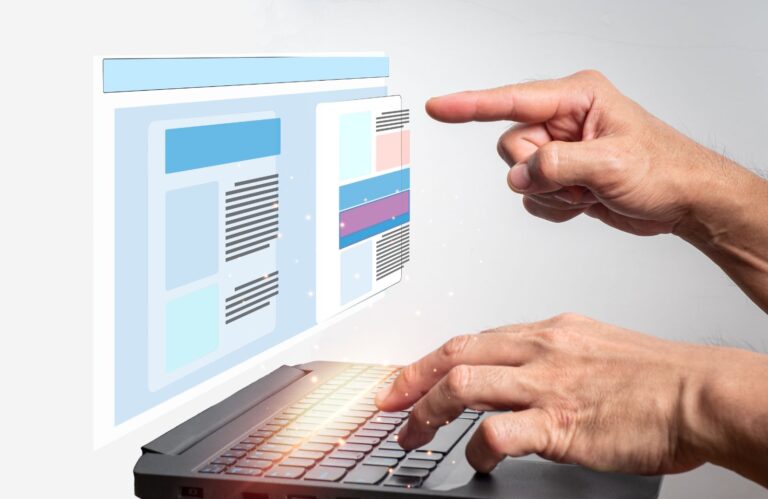What services do web designers offer
When you delve into the world of web design services, numerous questions might arise. What services exactly do web designers provide? How do these services align with the needs of your business? Determining if a web design company’s offerings match your business requirements can be quite challenging.
As you search for web design services, it’s crucial to look beyond aesthetics. The ideal company should not only transform your website visually but also ensure that its features serve your business objectives effectively. Don’t be captivated solely by flashy graphics and unnecessary embellishments.
A successful website should be purposeful, addressing the interests and challenges of your potential customers or target audience. Moreover, it should provide an experience that adheres to industry standards, preventing it from lagging behind in search engine rankings. Given the myriad options for web design services today, it’s imperative to select a company equipped to fulfill your comprehensive needs.
What Are Web Design Services?
The most intricate aspect of any website development, especially for a new site, is choosing the right design. While free templates available online can be downloaded and edited, they often limit the final appearance of your desired website. Alternatively, hiring a digital designer to craft an entirely unique design is an option.
The costs can vary significantly based on the extent of work required and the number of pages you desire. Moreover, don’t overlook the assistance other digital marketers can provide for different aspects of your website.
A web design service is essentially a blend of software, hardware, and human resources. Software refers to the coding performed by website developers, while hardware encompasses the website’s infrastructure, including server space, bandwidth, and disk space. Lastly, human resources encompass roles ranging from copywriters and web designers to project managers.
The Basic Web Design Services Offered
Below is a comprehensive list of responsibilities typically undertaken by a web designer. While the list is not exhaustive, it provides insight into the range of services clients can expect from their chosen web design agency:
- Custom website design and web development
- Redesign services
- Assistance with domain and web hosting
- Setting up Google Business Profiles (GMB)
- Crafting specific web pages
- Providing mood board and branding guidance
- Graphic design and logo creation
- On-page and off-page SEO (search engine optimization)
- Procuring relevant stock images
- Implementing DNS changes
- Creating site maps
- Embedding and linking videos
- Integrating forms
- Verifying on Google and other search engine result pages (SERPs)
Contrary to common belief, web design is not a straightforward process. A website’s cornerstone is user experience, capable of either elevating or hindering businesses. A single broken link or missing element can deter readers. If online success is your goal, enlisting the services of a professional web design company is essential.
Web Designers’ Additional Services
Web designers extend a wide array of additional services to enhance customer reach and lead generation. These services span several categories, including web design and development, content creation, content distribution, social media strategy, and analytics tracking. While web designers may appear commoditized, their value exceeds aesthetics.
A proficient web designer should possess expertise in using coding languages like HTML5, CSS3, Javascript, or PHP. These languages enable them to build custom functions catering to future website needs. Awareness of current web technologies such as responsive design, social sharing buttons, and secure forms is also crucial to impress search engines and users.
A skilled web designer not only understands the fundamental aspects of designing for various digital devices but also stays updated on trends within their field. These skills make them indispensable to businesses, particularly small enterprises.
Selecting the Right Web Designer
Choosing the perfect web designer for your business presents a challenge. The decision is pivotal, as it affects your website’s performance, lead generation, brand recognition, and reputation enhancement. Beyond aesthetics, a successful online presence necessitates clear messaging and understanding, both internally and externally.
Opt for a web marketing partner who comprehends your ideal customers, their pain points, and decision-making triggers. This partner should offer services encompassing digital media, retargeting, email marketing, eCommerce, social media optimization, and customer relationship management.
A collaborative web designer who aligns with your long-term objectives and can be a part of your team is essential.
The Value of a Skilled Web Designer
An adept web designer offers more than just an appealing design. They follow a series of best practices that contribute to your website’s efficacy:
- Effective Communication: A web designer grasps your mission and goals, seeking clarification if needed.
- Website Analysis: Utilizing tools like Google Analytics, a web designer extracts crucial insights to formulate an effective lead generation strategy.
- Follow-Up and Maintenance: A reliable web designer ensures your website continues to function optimally and remains available for queries or concerns.
Your Website: A Key Component of Your Marketing Strategy
The plethora of website designer options can be overwhelming. However, remember that your ultimate goal should guide your choice. A visually appealing website is not enough; it should also attract qualified traffic and convert visitors into customers.
A proficient web designer will guide you, provide training, and assist you in building a brand and culture around your website, fostering continuous lead generation and sales growth.
As you navigate the world of web design services, keep in mind that partnering with the right professionals can amplify your online success.
The Value of User-Centric Web Design
An indispensable aspect of effective web design is placing user experience at the forefront. User-centric design revolves around creating websites that cater to the needs, preferences, and behaviors of your target audience. This approach goes beyond aesthetics and delves into the realm of functionality, usability, and accessibility.
A user-centric web designer employs empathy to understand the challenges and expectations of users, ensuring that the website provides a seamless and enjoyable experience. From intuitive navigation to responsive layouts, user-centric design drives engagement, reduces bounce rates, and encourages conversions.
Elevating Your Brand Identity Through Design
Your website serves as a digital storefront, and its design is the first impression visitors encounter. A skilled web designer leverages design elements to capture the essence of your brand, creating a visual identity that resonates with your audience. From color palettes to typography, every design choice contributes to your brand’s perception and recognition.
Consistency in design elements reinforces brand identity, promoting familiarity and trust among your audience. An expert web designer crafts visuals that align with your brand’s values, enhancing the overall impact of your online presence.
Embracing Evolving Design Trends
Web design is a dynamic field, constantly evolving to meet the changing preferences of users and advancements in technology. A proficient web designer keeps pace with the latest design trends while discerningly integrating them into your website. Whether it’s adopting minimalist “flat” design or incorporating immersive storytelling through parallax scrolling, a skilled designer ensures your website remains contemporary and engaging.
A Mobile-First Approach to Design
With mobile devices accounting for a substantial portion of internet traffic, designing with a mobile-first approach is no longer optional—it’s imperative. A proficient web designer prioritizes mobile responsiveness, crafting websites that seamlessly adapt to various screen sizes and orientations. Mobile-first design guarantees that users on smartphones and tablets experience the same level of usability and engagement as those on desktops.
Incorporating Accessibility and Inclusivity
Web designers play a pivotal role in creating an inclusive online environment. They implement accessibility features that cater to users with disabilities, ensuring that everyone can access and navigate your website effortlessly. Incorporating alt text for images, providing captions for videos, and optimizing color contrast are just a few ways web designers enhance accessibility.
Conclusion: Crafting the Perfect Digital Experience
In the digital landscape, web designers are the architects of online experiences. Their role extends beyond aesthetics, encompassing functionality, user experience, branding, and adaptability. A well-designed website is a culmination of creativity, strategy, and technology, ensuring that your brand captivates and resonates with your audience.
As you embark on your journey to enhance your online presence, remember that a skilled web designer can transform your vision into a captivating reality. Whether you’re starting from scratch or revamping an existing site, collaborating with a web designer who embodies expertise, innovation, and user-centric design principles is essential.
FAQs
Why is user-centric web design important?
User-centric design prioritizes user needs, resulting in a website that’s intuitive, usable, and engaging, ultimately boosting user satisfaction and conversions.
How does web design influence brand identity?
Web design elements such as colors, typography, and visuals contribute to a consistent brand identity, fostering recognition and trust among users.
Why is staying updated with design trends crucial for web designers?
Design trends evolve to match user preferences and technology advancements. Web designers incorporate these trends to ensure websites remain contemporary and appealing.
What is a mobile-first design approach?
A mobile-first design approach involves designing for mobile devices first and then adapting the design for larger screens, ensuring a seamless experience across devices.
How do web designers ensure accessibility and inclusivity?
Web designers incorporate accessibility features, such as alt text for images and color contrast optimization, to ensure that all users, including those with disabilities, can navigate the website easily.






